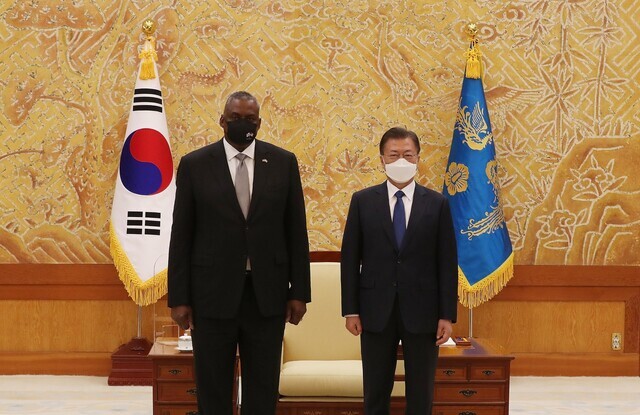hankyoreh
Links to other country sites 다른 나라 사이트 링크
[Editorial] S. Korea must consider implications of Taiwan Strait being included in security talks with US

For the first time in 11 years, the defense chiefs of the US and South Korea have decided to revise their operational plans on how to counter nuclear and missile threats from North Korea. The decision was made on Thursday during annual security talks between the two nations.
Furthermore, the Taiwan issue was mentioned for the first time in a joint statement made by South Korea and the US that day. This can be interpreted as a sign of strengthened cooperation between the Korea and US against both North Korea and China — a far cry away from the South Korean government’s calls for a declaration to formally end the Korean War.
Following the 53rd ROK-US Security Consultative Meeting, South Korean Minister of National Defense Suh Wook and US Secretary of Defense Lloyd Austin released a joint communique that stated that the two defense chiefs had “assessed that the updated planning guidance will guide military OPLANs [operations plans] to more effectively deter — and as necessary respond to — DPRK threats to the US-ROK Alliance,” while confirming that changes to the “Strategic Planning Guidance” had been approved. DPRK is an abbreviated form of the official name of North Korea.
Currently, OPLAN 5027 is in place to respond to an invasion of the South by North Korea, while OPLAN 5015 lays out procedures for responding to all-out war and other military contingencies. But with the advancements to North Korea’s nuclear and missile capabilities, it was decided that these operations plans also required updating. In particular, responses to North Korea’s submarine-launched ballistic missiles and hypersonic missiles are expected to be included in the revised plans.
At a press conference held that day, the question was raised as to whether these new steps run contrary to President Moon Jae-in’s calls for a declaration formally ending the Korean War. In response, Suh referred to an end-of-war declaration as a “political declaration,” stating that it would be difficult to draw any “specific relations” between an end-of-war declaration and the strategic guidance.
Another noteworthy point is that the joint statement made mention of the Taiwan Strait and also of 5G and next-generation mobile communications (6G). These issues come on account of Taiwan’s status as the geopolitical forefront of US-China rivalry while the area of 5G and 6G is a key field in the high-tech competition between the US and China for future military and industrial leadership. This content relating to the containment of China was first included in a joint statement made at the bilateral summit in May, and Thursday’s talks seem to have driven the point home.
The decision to include mentions of Taiwan and 5G and 6G in this recent statement shows that the alliance between South Korea and the US is moving beyond a focus on Korean Peninsula issues and is now incorporating efforts to keep China in check as the US-China competition for dominance intensifies.
However, it’s evident that South Korea cannot be forced to choose a side between the US and China and that it should not be dragged into any kind of external military disputes. In the event of a military dispute in the Taiwan Strait, peace in East Asia — including the Korean Peninsula — will inevitably be at stake.
As such, with Korea’s status as a middle power, Korean society must come to a consensus on what role the country will play in maintaining peace.
Please direct questions or comments to [english@hani.co.kr]

Editorial・opinion
![[Correspondent’s column] The real reason the US is worried about Chinese ‘overcapacity’ [Correspondent’s column] The real reason the US is worried about Chinese ‘overcapacity’](https://flexible.img.hani.co.kr/flexible/normal/500/300/imgdb/original/2024/0510/5217153290112576.jpg) [Correspondent’s column] The real reason the US is worried about Chinese ‘overcapacity’
[Correspondent’s column] The real reason the US is worried about Chinese ‘overcapacity’![[Editorial] Yoon’s gesture at communication only highlights his reluctance to change [Editorial] Yoon’s gesture at communication only highlights his reluctance to change](https://flexible.img.hani.co.kr/flexible/normal/500/300/imgdb/original/2024/0510/7717153284590168.jpg) [Editorial] Yoon’s gesture at communication only highlights his reluctance to change
[Editorial] Yoon’s gesture at communication only highlights his reluctance to change- [Editorial] Perilous stakes of Trump’s rhetoric around US troop pullout from Korea
- [Guest essay] Preventing Korean Peninsula from becoming front line of new cold war
- [Column] The state is back — but is it in business?
- [Column] Life on our Trisolaris
- [Editorial] Penalties for airing allegations against Korea’s first lady endanger free press
- [Editorial] Yoon must halt procurement of SM-3 interceptor missiles
- [Guest essay] Maybe Korea’s rapid population decline is an opportunity, not a crisis
- [Column] Can Yoon steer diplomacy with Russia, China back on track?
Most viewed articles
- 1[Correspondent’s column] The real reason the US is worried about Chinese ‘overcapacity’
- 2[Editorial] Yoon’s gesture at communication only highlights his reluctance to change
- 3Yoon rejects calls for special counsel probes into Marine’s death, first lady in long-awaited presse
- 4[Book review] Who said Asians can’t make some good trouble?
- 5Korea likely to shave off 1 trillion won from Indonesia’s KF-21 contribution price tag
- 6Nuclear South Korea? The hidden implication of hints at US troop withdrawal
- 7Korea poised to overtake Taiwan as world’s No. 2 chip producer by 2032
- 8Yoon voices ‘trust’ in Japanese counterpart, says alliance with US won’t change
- 9[Column] S. Korea’s low birth rate means its no time to gamble with the future
- 10Ex-President Moon Jae-in’s next career move? Bookshop owner